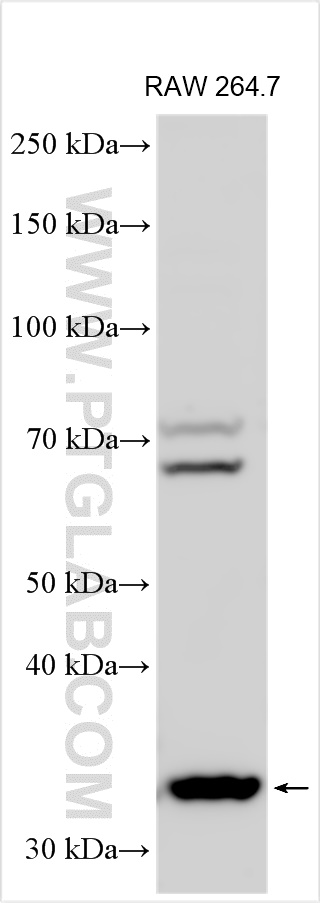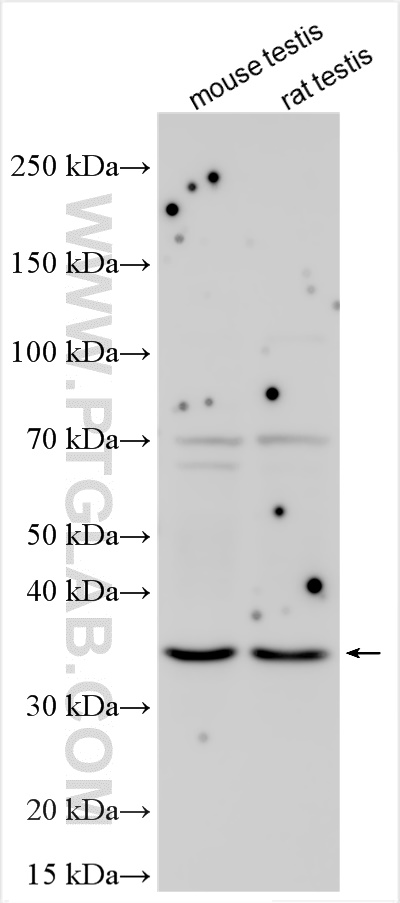验证数据展示
经过测试的应用
| Positive WB detected in | RAW 264.7 cells, mouse testis tissue, rat testis tissue |
推荐稀释比
| 应用 | 推荐稀释比 |
|---|---|
| Western Blot (WB) | WB : 1:500-1:2000 |
| It is recommended that this reagent should be titrated in each testing system to obtain optimal results. | |
| Sample-dependent, Check data in validation data gallery. | |
产品信息
14074-1-AP targets GNPTG in WB, ELISA applications and shows reactivity with human, mouse, rat samples.
| 经测试应用 | WB, ELISA Application Description |
| 经测试反应性 | human, mouse, rat |
| 免疫原 |
CatNo: Ag5153 Product name: Recombinant human GNPTG protein Source: e coli.-derived, PET28a Tag: 6*His Domain: 5-304 aa of BC014592 Sequence: LARLLLLLGLSAGGPAPAGAAKMKVVEEPNAFGVNNPFLPQASRLQAKRDPSPVSGPVHLFRLSGKCFSLVESTYKYEFCPFHNVTQHEQTFRWNAYSGILGIWHEWEIANNTFTGMWMRDGDACRSRSRQSKVELACGKSNRLAHVSEPSTCVYALTFETPLVCHPHALLVYPTLPEALQRQWDQVEQDLADELITPQGHEKLLRTLFEDAGYLKTPENEPTQLEGGPDSLGFETLENCRKAHKELSKEIKRLKGLLTQHGIPYTRPTETSNLEHLGHETPRAKSPEQLRGDPGLRGSL 种属同源性预测 |
| 宿主/亚型 | Rabbit / IgG |
| 抗体类别 | Polyclonal |
| 产品类型 | Antibody |
| 全称 | N-acetylglucosamine-1-phosphate transferase, gamma subunit |
| 别名 | N-acetylglucosamine-1-phosphotransferase subunit gamma, LP2537, GNPTAG, GlcNAc-1-phosphotransferase subunit gamma, CAB56184 |
| 计算分子量 | 34 kDa |
| 观测分子量 | 34 kDa, 68~70 kDa |
| GenBank蛋白编号 | BC014592 |
| 基因名称 | GNPTG |
| Gene ID (NCBI) | 84572 |
| 偶联类型 | Unconjugated |
| 形式 | Liquid |
| 纯化方式 | Antigen affinity purification |
| UNIPROT ID | Q9UJJ9 |
| 储存缓冲液 | PBS with 0.02% sodium azide and 50% glycerol, pH 7.3. |
| 储存条件 | Store at -20°C. Stable for one year after shipment. Aliquoting is unnecessary for -20oC storage. |
背景介绍
GlcNAc-phosphotransferase is a multisubunit enzyme with an α2β2γ2 arrangement that requires a detergent for solubilization. Recent cloning of cDNAs and genes encoding these subunits revealed that the α- and β-subunits are encoded by a single gene as a precursor, whereas the γ-subunit is encoded by a second gene. Sugar composition and/ or additional modifications which alter the charge of the GNPTAG oligosaccharide chains are variable in a cell type-depending manner.
实验方案
| Product Specific Protocols | |
|---|---|
| WB protocol for GNPTG antibody 14074-1-AP | Download protocol |
| Standard Protocols | |
|---|---|
| Click here to view our Standard Protocols |



